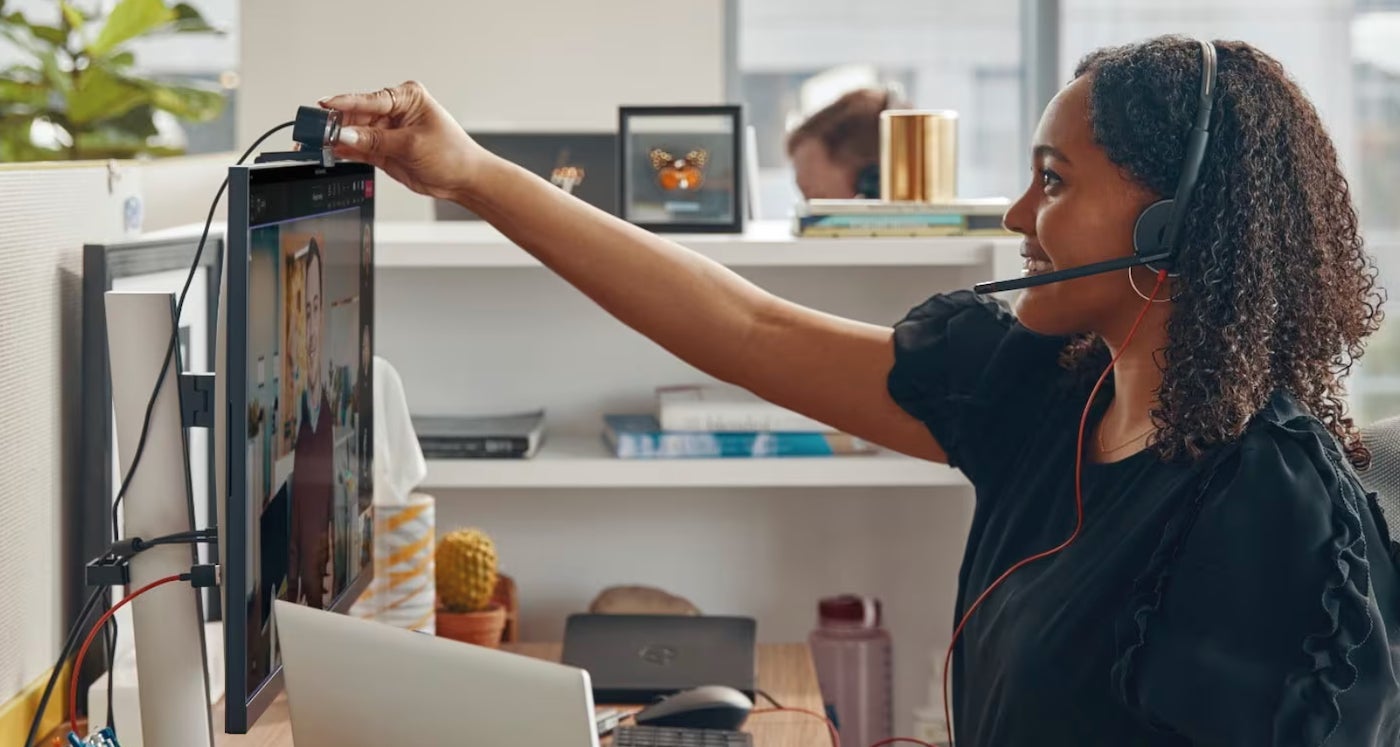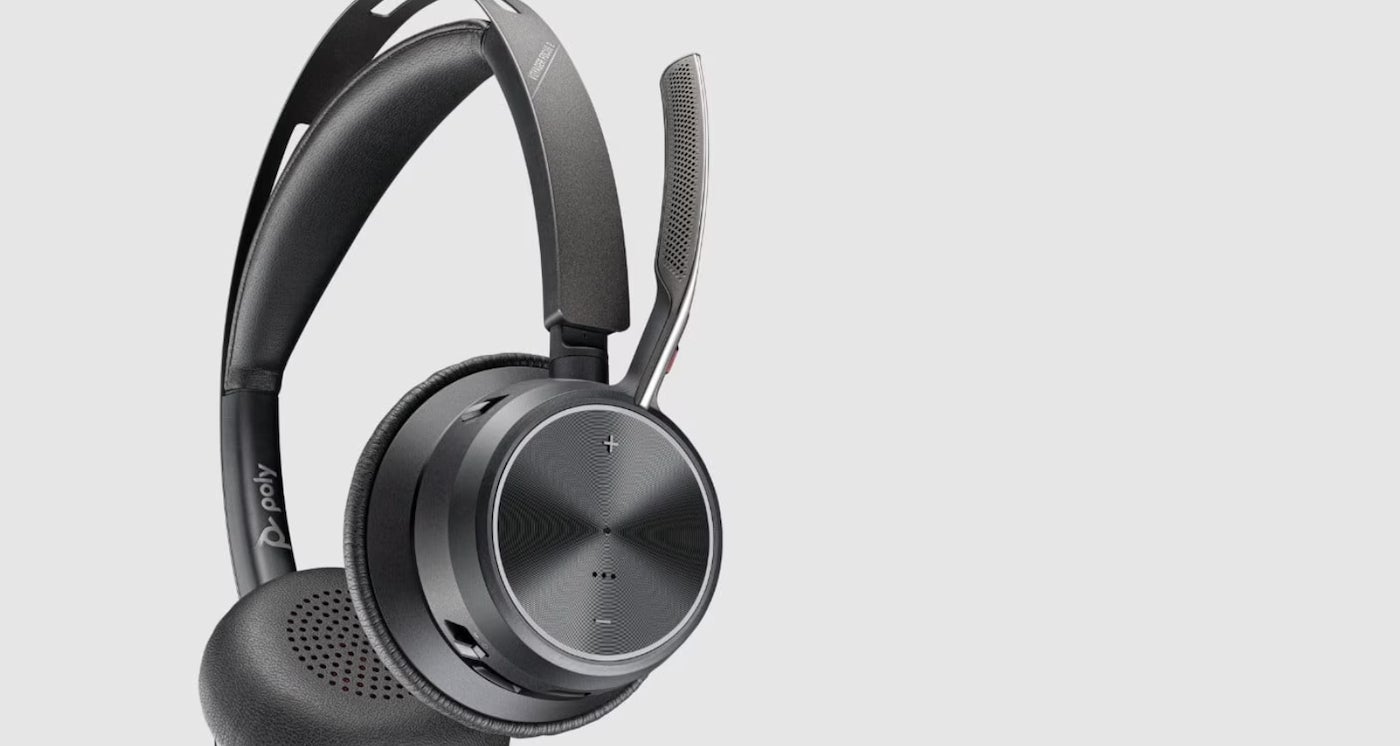
VoIP headsets can make or break the user experience — it’s important to be choosy when it comes to comfort and audio quality. After all, there’s a massive difference between wearing a headset that’s uncomfortable in the first five minutes and one that’s great all day.
This guide covers five of the best VoIP headsets and which to choose based on key factors like audio quality, noise cancellation, comfort, connectivity, and battery life.
Every call center agent will have different preferences with their VoIP headset, but what’s most important is that the headset delivers great call quality while reducing background noise and is comfortable enough to be worn throughout the day. Here’s a closer look at how the top VoIP headsets options compare.
When you combine all day comfort with a reasonable price point, the Poly Blackwire series is hard to beat. Offering both an over-ear style for full call immersion and a one-ear option, it’s versatile to match agent preferences.
The entire series is refreshingly simple and certified for use with Zoom, Microsoft Teams, and Google Meet.
This is the only wired VoIP headset on my list. Even though they’re getting harder to find, I appreciate the lower price point and not having to worry about charging a battery. With built-in equalizing, two cord options (USB-C to USB-A and 3.5 mm), and a noise-canceling microphone, you get superior call quality at a fraction of the price.
The Poly Blackwire series comes in various versions and bundles:
There’s a remote work bundle that includes a keyboard, mouse, and webcam. There are also a few upgraded versions that have better speakers and microphones and a carrying case.
You can buy them from Amazon, Staples, or HP directly.
| Pros | Cons |
|---|---|
| Lightweight and comfortable. | There’s a limited range. |
| Strong audio quality. | Multiple options can be confusing. |
| Sufficient noise cancellation. | It’s not top-of-the-line. |
| Works with any device. | |
| No issues with durability. | |
| Affordable price point. | |
| Don’t have to worry about charging. |
If audio quality for calls, music, and movies is your top priority, the MB 660 UC is the best it gets. As part of Sennheiser’s unified communications (UC) line, it’s compatible with just about every platform, including Teams, Zoom, Skype, and more.
Unlike the Poly Blackwire series, it uses a Bluetooth connection with a 30-hour battery life. It’s easy to pair with any device, eliminating the need for wires and adapters.
Plus, the headset’s active noise cancellation and SpeakFocus 3-microphone system makes it a great fit for users in open office environments with a lot of noise or working from home.
When it comes to audio, Sennheiser has a reputation as being one of the top brands on the market. The Sennheiser MB 660 UC VoIP headset delivers on that (and then some). It offers crystal-clear audio, along with outstanding active noise cancellation for busy office environments and the outdoors. This along with personalized sound settings, such as Club, Movie, Speech, and Director mode, make it a true standout for audio quality.
There are two versions of the MB 660 UC — one that’s universal and one specifically for Skype for Business users. You can purchase either from a range of different places including Amazon, Headsets.com, or directly from Sennheiser.
Price varies, but typically starts around $445.

| Pros | Cons |
|---|---|
| Comes with 2.5mm, 3.5mm, and USB to micro-USB adapter just in case. | One of the most expensive options. |
| Superior noise cancellation capabilities. | Touch controls can take getting used to. |
| Multiple audio modes for top-notch audio quality. | Bulkier than others. |
| Easy call handling via touch. | |
| You don’t have to remove it to talk to people in the same room. | |
| Impressive 30-hour battery life. |
Like the MB 660, the Jabra Evolve 75 SE connects with Bluetooth, giving agents the option to move around — up to 100 feet away. One of its unique features is a busylight that lets others know you’re on a call. Whether you have kids and a spouse running around at home or colleagues asking questions at work, they’ll know when to avoid interrupting you.
With intuitive audio controls, passive noise cancellation, active noise cancellation, and the ability to let in ambient noise (like nearby voices), users get full control.
For removing background noise and ensuring clear audio, it doesn’t get much better than the Jabra Evolve 75 SE. Even in busy environments, callers hear nothing but your agents who won’t have to worry about loud noises getting in their way.
You can even connect it to multiple devices at the same time, making it a strong option for users who switch between devices.
The Jabra Evolve 75 SE is available from multiple carriers, including Lenovo, Amazon, Jabra, and Headsets Direct. You can choose to optimize it for Microsoft Teams or universal use.
The price varies by carrier, but tends to start around $403.

| Pros | Cons |
|---|---|
| Eliminates background noise for the wearer and person on the other end. | Not the cheapest option. |
| Crystal-clear audio. | Steeper learning curve. |
| Comfortable for extended wear. | Could have a longer battery life (18 hours compared to others with 25+). |
| Unique busy light indicator. | |
| Dual Bluetooth connectivity for switching devices. | |
| 100-foot range. |
The Poly Voyager Focus 2 was designed to prioritize comfort without sacrificing essential noise cancellation, audio quality, and battery life. Although it’s heavier than other options, it features a padded headband and superior ear cushions, making it one of the most comfortable options for agents who wear a headset all day.
While this VoIP headset is a clear winner for comfort, it also includes acoustic fence technology (ensures callers only hear you), advanced active noise cancellation with three settings, dynamic mute alerts, and intuitive call controls.
It offers an excellent balance of comfort, functionality, quality, and ease of use at a more approachable price point.
Poly offers Microsoft Teams and universal editions with or without a charging stand:
You can buy them from Best Buy, HP, Amazon, Walmart, and other online retailers. HP also offers a Remote Collaborator bundle with the headset, a computer monitor, USB-C connectivity dock, webcam, wireless mouse, and keyboard for $937.

| Pros | Cons |
|---|---|
| Half the price of more expensive alternatives. | Heavier and bulkier than most others. |
| Designed around all-day comfort. | Extra padding can get warm. |
| Multi-device connectivity. | Not the cheapest option. |
| All-day battery life. | |
| Clear audio quality on both ends. | |
| Wireless range up to 164 feet. | |
| Optional USB mode. |
The Poly Savi 8410 uses DECT connectivity, giving it the longest range on my list. At 590 feet, you get six times as much space to move around. It’s a great choice for employees who work from home or need the ability to walk around during calls.
While it has a much shorter battery life than most, its impressive range makes it a standout choice. It also offers background noise cancellation for the wearer and a noise cancellation microphone for crystal clear audio on the receiving end. The Poly Savi base can connect to your computer, desk phone, and mobile phone simultaneously, making it easy to use no matter what device you’re using. It’s also the lightest option for all day comfort.
DECT connectivity is a newer alternative to Bluetooth. As with most new tech, it’s expensive — the price starts around $490, making it the most expensive option I reviewed.
You can buy it from a wide range of carriers, including Headsets Direct, HP, and Amazon.

| Pros | Cons |
|---|---|
| Very lightweight and comfortable. | Shorter battery life than most. |
| Plenty of range to move around as needed. | Very expensive compared to others. |
| Pair with three devices at the same time. | Only covers one ear. |
| Adequate noise cancellation. | |
| Voice prompts that tell you when you’re too far away or on mute. | |
| Intuitive display for audio settings. |
The first thing to think about is the style of VoIP headsets you want. Each type has its own pros and cons, but many times it comes down to personal preference. Options include:
That decision will narrow your search significantly. You can narrow it further by deciding what type of connectivity you need. You can choose from USB, standard headphone jack, and Bluetooth. Some may also offer digital enhanced cordless telecommunications (DECT).
Wired options (USB and headphone jack) mean you don’t have to worry about charging, but it can feel restrictive. Cords can also get tangled, which is a frustrating experience.
Wireless VoIP headsets (Bluetooth and DECT) have more range but require regular charging.
Many wireless headsets also come with wires, letting the user choose which type of connectivity they prefer. Some even include 3.5mm and various USB adaptors to work with multiple devices.
The next major consideration is your budget. You can use that to narrow it down to a handful of choices. From there, I suggest looking at customer reviews, editorial reviews (like this one), and trying them out in store if you can.
Before buying, make sure they’re compatible with the VoIP system you use.
SEE: Check out the best VoIP systems of 2024.
I started with a massive list of VoIP headsets from various providers. I narrowed it down to my top five using the following factors combined with my own experiences.
Call centers, offices, coffee shops, and homes are noisy environments. Minimizing background and environmental noise is often the only way to ensure clear audio.
Being able to hear the person on the other end is just as crucial as them being able to hear you. I intentionally chose a mix of simple products with no audio settings and advanced options for those who want to fine-tune their experience.
Users often spend hours each day with their headsets on. It’s important to find an option that doesn’t hurt the wearer’s ears or damage their hearing.
I wanted to highlight a combination of wired and wireless options. To me, a wired connection makes everything easier since they’re cheaper and you don’t have to worry about charging.
However, high-quality wired headsets are hard to find and there are plenty of people who’d love to argue with me about the pros and cons of each.
A 16-hour battery life is preferred as this gives users the ability to use them for up to two work days before having to recharge. Those with a shorter battery life must have other features that make up for the limitation.
Covering a range of price points was intentional. Not everyone needs the best of the best, some just want something affordable that works.